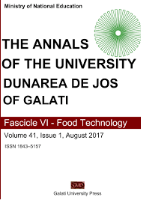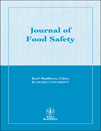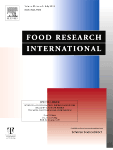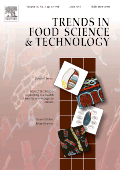
EFSA Journal
Scope & Guideline
Championing excellence in animal and food research.
Introduction
Aims and Scopes
- Food Safety and Risk Assessment:
The journal focuses on comprehensive risk assessments related to food safety, including the evaluation of pesticide residues, food additives, and genetically modified organisms (GMOs). It aims to provide evidence-based assessments that inform regulatory decisions. - Environmental Risk Evaluation:
The journal publishes studies and opinions on the environmental impact of food production and safety, particularly concerning the effects of pesticides and other agricultural practices on ecosystems. - Innovations in Food Technology:
Research related to novel foods, food additives, and food processing technologies is a core area, highlighting advancements that ensure food safety and quality. - Microbiological Safety:
The journal emphasizes the importance of assessing microbiological hazards in food and feed, addressing emerging threats such as antimicrobial resistance (AMR) and zoonotic diseases. - Regulatory Guidance and Frameworks:
It provides guidance on regulatory frameworks for food safety, including methodologies for evaluating health claims and safety assessments for new food products.
Trending and Emerging
- Cumulative Risk Assessment:
There is an increasing emphasis on cumulative dietary risk assessments, which consider the combined exposure to multiple chemical contaminants and their potential health impacts. - Environmental and Ecotoxicological Assessments:
Emerging themes include the assessment of environmental impacts of food production systems, particularly regarding biodiversity and ecosystem health. - Microbial Risk Analysis and AMR:
Research on antimicrobial resistance (AMR) and microbiological safety is on the rise, reflecting concerns over foodborne diseases and resistance development in pathogens. - Novel Foods and Ingredients:
The evaluation of novel foods, including insect proteins and plant-based alternatives, is trending, addressing consumer demand for sustainable food sources. - Integrated Approaches to Testing and Assessment (IATA):
There is a notable trend towards using integrated methodologies for risk assessment, combining various scientific disciplines to enhance the reliability of food safety evaluations.
Declining or Waning
- Traditional Pesticide Risk Assessments:
There appears to be a reduction in the frequency of traditional pesticide risk assessments in favor of more integrated approaches that consider cumulative risks and broader ecological impacts. - Single-Substance Evaluations:
The focus has shifted from evaluating individual agricultural chemicals to more comprehensive assessments that consider mixtures and their combined effects on health and the environment. - Conventional Food Additives:
Research on conventional food additives is becoming less prominent as regulatory bodies move towards evaluating more innovative food ingredients and natural alternatives. - General Health Claims:
The EFSA Journal has seen a decline in generalized health claims in favor of more precise evaluations related to specific nutrients or bioactive compounds.
Similar Journals

Food Quality and Safety
Bridging knowledge gaps in the food industry.Food Quality and Safety is a leading academic journal published by Oxford University Press, dedicated to advancing research in the critical field of food science. With an ISSN of 2399-1399 and an E-ISSN of 2399-1402, the journal has gained prestigious recognition, securing a Q1 ranking in the Food Science category as per Scopus rankings, and being positioned at #69 out of 389 in its field, reflecting its influence and reputation within the discipline. Since its transition to Open Access in 2017, the journal has broadened its reach, ensuring that cutting-edge research related to food quality, safety measures, and consumer protection is accessible to researchers, professionals, and students alike. With a commitment to publishing high-quality articles and reviews, the journal addresses contemporary challenges in the food industry and promotes a better understanding of food safety protocols. Based in Oxford, United Kingdom, Food Quality and Safety plays a pivotal role in shaping future research and practices in food science, making it an essential platform for scholars who aim to impact the industry through innovative findings and applied research.

Annals of the University Dunarea de Jos of Galati, Fascicle VI-Food Technology
Empowering Knowledge in Food ProcessingAnnals of the University Dunarea de Jos of Galati, Fascicle VI-Food Technology is a distinguished academic journal published by GALATI UNIV PRESS, dedicated to advancing knowledge in the field of food technology. With an open access format since 2007, this journal enhances accessibility to research findings and facilitates the dissemination of innovative ideas among researchers, professionals, and students worldwide. The journal holds a noteworthy position in its category, boasting a 2023 Q3 ranking in both Food Science and Industrial and Manufacturing Engineering, indicating its relevance and contribution to these critical fields. As it converges years of publication from 2012 to 2023, it encapsulates an evolving body of knowledge that reflects the latest advancements and research trends. Although it may not yet have a defined HIndex, its presence in Scopus with ranks of #253 in Industrial and Manufacturing Engineering and #278 in Food Science underscores its emerging impact. This journal is particularly significant for those engaged in research related to food technology and engineering, facilitating dialogue and collaboration within the community while addressing pressing challenges and innovations in food processing and safety. With its commitment to quality research, Annals of the University Dunarea de Jos of Galati serves as an essential resource for fostering knowledge and promoting scientific discussion.

International Food Research Journal
Bridging Disciplines in the World of Food ResearchThe International Food Research Journal, published by UNIV PUTRA MALAYSIA PRESS, serves as a pivotal platform for disseminating innovative research within the field of food science. With an ISSN of 1985-4668 and an E-ISSN of 2231-7546, the journal has successfully established its presence since its inception in 2007, converging its findings through 2024. This esteemed journal holds a Q3 ranking in Food Science, illustrating its valuable contributions to the field as demonstrated by its Scopus rank of 276 out of 389, placing it in the 29th percentile among its peers in Agricultural and Biological Sciences. Although it operates under a traditional publishing model, its academic integrity and focus on high-quality research ensure that it remains a vital resource for researchers, professionals, and students eager to explore advances in food technology, nutrition, and safety. By encouraging interdisciplinary collaboration and critical dialogue, the International Food Research Journal plays an essential role in shaping the future of food science research.

JOURNAL OF FOOD SAFETY
Connecting researchers to the pulse of food safety advancements.Journal of Food Safety is a premier resource in the field of food science, offering invaluable insights into food safety practices, microbiology, and parasitology. Published by WILEY, this journal has been a pivotal platform for the dissemination of research since its inception. With an impressive impact factor reflecting its esteemed reputation, the journal caters to a diverse audience of researchers, professionals, and students committed to advancing knowledge in food safety. While currently not an open access journal, it still provides essential findings that contribute significantly to the understanding of foodborne pathogens and preventive measures. Recognized in the Q2 and Q3 quartiles across various relevant disciplines, including Food Science, Microbiology, and Parasitology, the Journal of Food Safety continues to uphold high standards in scientific research and education. Researchers are encouraged to submit their manuscripts and engage with groundbreaking studies that are shaping the future of food safety.

CZECH JOURNAL OF FOOD SCIENCES
Fostering Collaboration in Food Science InnovationCzech Journal of Food Sciences is a premier publication in the field of food science, disseminating vital research since its inception in 1999 and transitioning to Open Access in 2007. Published by the Czech Academy Agricultural Sciences, this journal facilitates the exchange of knowledge among researchers, professionals, and students dedicated to advancing the understanding of food systems, safety, and technology. With an ISSN of 1212-1800 and an E-ISSN of 1805-9317, it holds a respectable position with a Q3 ranking in the Food Science category for 2023, illustrating its commitment to high-quality research despite its Scopus rank of 209 out of 389, situated in the 46th percentile. Located in the heart of the Czech Republic, at TESNOV 17, PRAGUE 117 05, this journal serves as an essential resource for those involved in agricultural and biological sciences, paving the way for innovative discoveries and applications in food science.

FOOD RESEARCH INTERNATIONAL
Driving Excellence in Food ResearchFOOD RESEARCH INTERNATIONAL is a premier academic journal published by ELSEVIER, specializing in the field of Food Science. With an impressive impact factor and ranked Q1 in the 2023 category quartiles, it stands at the forefront of research, positioned 17th out of 389 in the Scopus ranking for Agricultural and Biological Sciences, attaining a commendable 95th percentile. The journal publishes high-quality, peer-reviewed articles that cover a broad spectrum of topics, including food safety, quality control, nutrition, and biotechnology, making it an invaluable resource for academics, industry professionals, and students alike. As FOOD RESEARCH INTERNATIONAL seeks to enhance understanding and advance technologies related to food, it encourages innovative perspectives and interdisciplinary research. The journal, active from 1992 and continuing through 2024, is an essential platform for disseminating vital findings and fostering collaboration within the global food science community.

TRENDS IN FOOD SCIENCE & TECHNOLOGY
Transforming knowledge into culinary breakthroughs.Trends in Food Science & Technology, published by Elsevier Science London, stands as a premier journal in the fields of food science and biotechnology. With an impressive Q1 ranking in both the food science and biotechnology categories, it is recognized for its rigorous peer-reviewed articles that advance knowledge and innovation in the sector. The journal’s Scopus rankings validate its significance, placing it in the top percentile among its peers, with a remarkable rank of #2 out of 389 in Agricultural and Biological Sciences - Food Science, and #4 out of 311 in Biochemistry, Genetics, and Molecular Biology - Biotechnology. Since its inception in 1990, the journal has become a vital resource for researchers, professionals, and students alike, offering insights into contemporary challenges and trends impacting food technology. Although it operates under a subscription model, the quality of research published within its pages makes it an essential read for anyone involved in advancing the science of food.

Ukrainian Food Journal
Advancing food science through innovative research.Ukrainian Food Journal is an esteemed open-access journal dedicated to advancing the field of food science and biochemistry. Established in 2012 and published by the National University of Food Technologies in Ukraine, the journal serves as a vital platform for researchers and professionals to disseminate their findings on food technology, safety, and nutritional biochemistry. With an ISSN of 2304-974X and E-ISSN 2313-5891, it offers a wealth of knowledge to its readers, promoting innovation and collaboration within the industry. While currently categorized within the Q4 quartile of biochemistry and the Q3 quartile of food science, the journal is progressively gaining recognition, reflecting a commitment to quality research in a competitive field. The journal is indexed in Scopus, ranking #271 in Food Science and #376 in Biochemistry, underscoring its relevance and contribution to agricultural and biological sciences. The Ukrainian Food Journal not only enriches the academic community with its open-access model but also aims to foster dialogue among researchers, professionals, and students dedicated to improving food systems and nutrition. It operates from its headquarters in Kyiv, offering a hub for creativity and advancement in food-related research.

Journal of Consumer Protection and Food Safety
Championing knowledge in consumer protection and food safety.Journal of Consumer Protection and Food Safety, published by SPRINGER INT PUBL AG, is an esteemed periodical aimed at advancing knowledge in the fields of agronomy, biotechnology, food science, and veterinary food animals. With a Scopus ranking in the Q3 category for 2023, this journal plays a vital role in disseminating research that informs consumer safety and the responsible production of food. Covering a wide array of topics from food safety regulations to innovative practices in food production, the journal serves as a crucial resource for researchers, professionals, and students alike. The journal's commitment to bridging the gap between academic research and practical applications ensures that it remains relevant and influential in shaping future policies and technologies within the industry. The journal is accessible through traditional subscription methods, fostering a community of scholars united in enhancing food safety standards globally.

Food Additives and Contaminants Part A-Chemistry Analysis Control Exposure & Risk Assessment
Elevating standards in food science and toxicology.Food Additives and Contaminants Part A-Chemistry Analysis Control Exposure & Risk Assessment, published by Taylor & Francis Ltd, is a leading journal in the field of food science, toxicology, and public health. With an ISSN of 1944-0049 and an E-ISSN of 1944-0057, this esteemed publication has established itself as a vital resource for researchers and professionals involved in the analysis and regulation of food additives and contaminants. Since its inception and through its converged years from 2008 to 2012 and again from 2014 to 2023, the journal has maintained an impactful presence, notably achieving a Q2 ranking in diverse categories including Chemistry (miscellaneous) and Food Science, alongside commendable standings in Health and Environmental Health. The journal’s mission is to foster high-quality research by providing a platform for critical studies related to chemical analysis, exposure assessments, and risk management in food safety. By prioritizing engaging, peer-reviewed content, it aims to enhance understanding and mitigate risks associated with food additives, making it an indispensable tool for academics, practitioners, and policymakers alike.